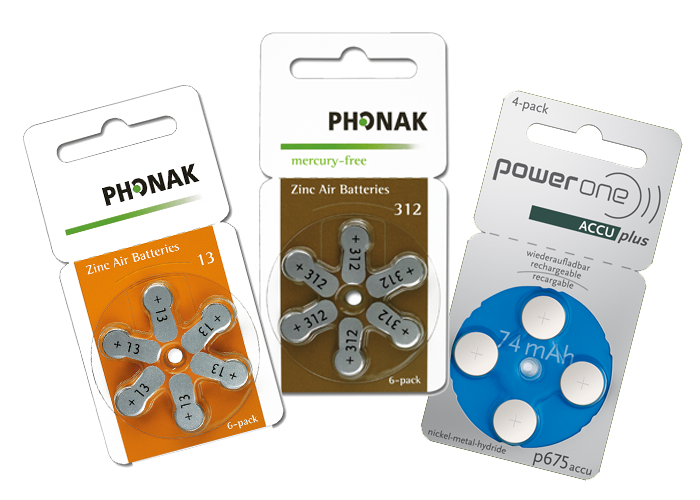
FAQs

Standard Zinc Air and Mercury Free Zinc Air Hearing Aid Batteries
Why do we offer Mercury Free batteries?
It’s green!
As battery technology advances, the focus is on mercury free batteries.
More and More countries are now legally required to use mercury free batteries, and the number is growing yearly. Mercury Free technology is State of the Art and the only battery fulfilling the new IEC Standard defined for streaming HI’s. Key parameter in the IEC Standard is 15min non stop Streaming. During this 15 min a very high current is drawn from the battery, if the battery is not specifically made for this purpose there is a high risk that the HI stops or partially interrupts.
How are Mercury Free batteries different from Standard batteries? How do they compare to each other in performance?
The running time for Mercury Free and Standard batteries is equal when used within the same category of hearing instruments. Mercury Free cells are also more environmentally friendly because there is no mercury added to the cell.
The Mercury Free cells are developed for new requirements of hearing aids with wireless functionality.
Note: Be aware that for hearing instruments with wireless functions, battery life in general is shorter than it would be with a non-wireless hearing instrument. This is independent of battery composition (Mercury Free or Standard Zinc Air).
Can Mercury Free batteries be used in any hearing aid?
Yes.
Why do Zinc Air hearing aid batteries have a tab?
Zinc Air hearing aid batteries use air as an energy source, and the tab seals the air holes on the battery. Once the tab is removed, it takes approximately two minutes before the hearing aid battery is activated/charged. At that point, the battery compartment can be closed. If not activated correctly the battery can in the worst case be damaged and will not come back to normal Voltage level needed!
Please remember not to remove the tab before the hearing aid battery is to be used. Reattaching the tab will not prolong the running time of the battery.
How long is the Zinc Air battery’s shelf life?
Our batteries have a minimum “shelf-life” of two years. However, this estimate cannot be guaranteed if the batteries were previously stored incorrectly.
How should hearing aid batteries be stored?
Optimal room storage temperature for storing hearing aid batteries is between 10 and 25°C. Heat may shorten the running time and a humid environment is not suitable for storage. Finally, avoid storing hearing aid batteries in the refrigerator.
Contact with metal objects such as keys or coins can cause a hearing aid battery to short-circuit, therefore it is recommended to never carry individual batteries loose in a purse, wallet or handbag.
What do I do if a battery is swallowed?
Hearing aid batteries, whether they are used or new, must be stored out of the reach of small children and pets to prevent them from swallowing a battery. If batteries are ingested, seek medical help immediately.
What are the various sizes of hearing aid batteries?
The standard sizes of the hearing aid batteries are 10, 13, 312 and 675. They are color-coded for easy identification:
- size 10: yellow
- size 312: brown
- size 13: orange
- size 675: blue
How does a hearing aid battery deliver its best performance?
Please make sure you protect the hearing aid battery air holes from moisture. If the battery should get wet due to sweating or other, dry it!
Switching off your hearing aid when not in use will also prolong the life of the battery!
How long is the running time of a hearing aid battery?
The running time of the hearing aid battery depends on the hours of use per day, the amplification and the type/features of the hearing aid being used. Streaming has a direct influence on the running time of a battery due to the high currents the HI draws in this mode. As the streaming mode is activated automatically running times of batteries vary depending on how often and how long streaming is active over the day.
Do more air holes mean a longer battery life and greater power?
An important factor for longer battery life and greater power is the quality and design of the electrodes. The number and size (diameter) of the air holes have as well an influence on the power of the battery.
How do I dispose a used hearing aid battery?
Zinc Air button cell batteries are classified as non-hazardous waste. However it is recommended to bring the batteries to the common local collecting points for batteries to make sure they can be recycled.
Why is my hearing aid not working despite having a new battery?
There could be several reasons for this. Here are some things to check:
- Not enough time for battery to be activated/”charged” after removal of the tab.
- Dented battery surface causes poor contact with battery terminal of the hearing aid.
- Battery is dead (even if it is brand new). This is very rare. Can as well happen when not activated correctly!!
Built up dirt on the battery terminal of the hearing aid causes poor contact. - In very rare circumstances it can happen that the battery due to a technical reason cannot be activated. Then replace the battery.
lf hearing aid does still not work properly after replacing with a new battery (wait two minute after removing the tab before use) please take your hearing aid to your hearing care provider for further troubleshooting.
When might a hearing aid battery expand and leak?
If the discharged battery is left in the hearing aid after end of life, humidity can influence the battery chemistry and lead to swelling, especially in extreme weather conditions such as a tropical environment. Once a battery is at the end of its life, it should be removed from the hearing aid.
Why does my hearing aid battery suddenly last a shorter time?
Statistics show that, in most of the cases, the reasons for a short running time are not necessarily production faults, but rather:
- Environmental influences (e.g. humidity, temperature).
- Personal hearing habits have changed (longer period of use per day, higher noise level, new features of the hearing aid are being used).
- The hearing aid was in use longer than usual (e.g. night at the theater).
- The hearing aid is new, or the type or brand of the hearing aid has changed.
- The new hearing aid has additional features that require more energy, for example streaming.
Improper handling can also reduce the running time of the hearing aid battery, e.g.:
- The battery tab is removed and activation period was too short!! It has to be 2 Min or more! before it is inserted into the hearing aid.
- The hearing aid is not switched off over night or after a long period of non-use.
- The battery loses capacity due to a short circuit when mishandled (e.g. through contact with metal objects).
- The battery is stored in a warm environment (e.g. in a parked car in the sun).
power one ACCU plus Batteries (cells)
In which sizes are the power one ACCU plus cells available?
The rechargeable hearing aid cells are available in the sizes p10accu, p13accu, p312accu and p675accu.
For which hearing aids can I use the power one ACCU plus cells?
They can be used in most hearing aids of the relevant size. In order to charge the ACCU plus cells, several power one charging solutions can be used.
Which are the main advantages of the power one ACCU plus cells with NiMH technology?
These fast chargeable batteries are ecologically sound. By using our rechargeable button cells, you help to protect the environment. The rechargeable batteries do not contain any heavy metals like mercury, cadmium or lead.
These high-performance NiHM batteries are characterized by their excellent reliability and quality without any memory effect. All power one batteries are made in Ellwangen/Germany and are subjected to strict safety and quality checks.
How shall I treat my power one ACCU plus cells?
Please ensure that the mating surfaces of the power one ACCU plus and inside the appliance are kept clean. For best results and product life, please avoid deep discharging or short circuiting the battery at all times. The batteries should be stored at a room temperature of 20-25 degrees without their product life being affected.
Why does my new power one ACCU plus cell not work properly?
Charging in inferior charging devices without a battery charge indicator and shut-off function can harm your batteries or impact the capacity of the cell. We therefore recommend to use our power one charging solutions.
What running time can I expect from my rechargeable hearing aid cells?
Physically determined rechargeable hearing aid batteries (NiMH-technology) have a lower energy density compared with zinc air hearing aid batteries (primary cells). This is expressed through a lower capacity, which is consistent with just approx. 1/10 of the capacity of primary cells. In exchange the rechargeable hearing aid cells could be recharged approx. 500 times.
In hearing aid devices can be count on that the accu capacity is sufficient for one day, if one and the same hearing aid device with zinc air batteries reaches at least 10 days running time.
Has a new power one ACCU plus cell immediately it’s full capacity?
No. A new rechargeable battery reaches its full capacity not before having passed some charge-/discharge cycles.
How shall I charge and store my power one ACCU plus cells?
The recommended temperature range for charging and storage is at room temperature (20–25 degrees).
Shall I take my power one ACCU plus cells in case of longer non-use out of my hearing aid device?
Yes. Even in passive state there circulates a low current which can cause deep discharge
after a longer time. Deep discharge can harm the battery and lead to an irreversible loss
of capacity.
Downloads

Guide: FAQ Zinc Air Batteries

